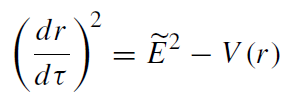
Equations of motion of a free test particle
 المؤلف:
Heino Falcke and Friedrich W Hehl
المؤلف:
Heino Falcke and Friedrich W Hehl
 المصدر:
THE GALACTIC BLACK HOLE Lectures on General Relativity and Astrophysics
المصدر:
THE GALACTIC BLACK HOLE Lectures on General Relativity and Astrophysics
 الجزء والصفحة:
p 129
الجزء والصفحة:
p 129
 2-2-2017
2-2-2017
 1684
1684
Equations of motion of a free test particle
1.1 Orbits are planar
Consider a particle moving in the Schwarzschild metric. Using spherical symmetry, one can always choose coordinates so that at the initial moment τ0 one has θ0 = π/2 and (dθ/dτ)|0 = 0. Since the only non-vanishing components of Γθμν are
 (1.1)
(1.1)
the θ-component of the geodesic equation of motion takes the form
 (1.2)
(1.2)
A solution of this equation for the given initial data is θ = π/2. Thus, the trajectory of a particle is planar and we can assume it to lie in the equatorial plane θ = π/2.
1.2 Effective potential
The Schwarzschild metric is invariant under time t and angular coordinate φ translations. The corresponding conserved quantities are (θ = π/2):
 (1.3)
(1.3)
 (1.4)
(1.4)
Ẽ = E/m is the specific energy of a particle (E being the energy, and m being the mass of the particle). The quantity l = L/m is the specific angular momentum of a particle (L being its angular momentum). For the motion in the equatorial plane, the total angular momentum coincides with the azimuthal angular momentum. For a motion of the particle in the black hole exterior, both t and φ are monotonic functions of τ .
Using these relations and the normalization condition for the four-velocity uμ
 (1.5)
(1.5)
one gets :
 (1.6)
(1.6)
where we introduced the effective potential
 (1.7)
(1.7)

Figure 1.1. Effective potential U(x) as a function of x = r/rS and for a specific angular momentum ˜L of a particle.
1.3 Properties of the effective potential
Different types of particle trajectory can be classified by studying the turning points of its radial motion where
V (r ) = Ẽ2. (1.8)
The only scale parameter in the problem is the gravitational radius of the black hole. Using again the dimensionless coordinate x and ˜L = l/rS we can rewrite V (x) according to
 (1.9)
(1.9)
The effective potential U(x) is shown in figure 1.1. For fixed |˜L | ≥ √3, U as a function of x has a maximum at x+ and a minumum at x−, where
 (1.10)
(1.10)
For ˜L = √3, x− = x+ = 3. A heavy full line in figure 5.1 shows the position of the extrema.
 الاكثر قراءة في الثقوب السوداء
الاكثر قراءة في الثقوب السوداء
 اخر الاخبار
اخر الاخبار
اخبار العتبة العباسية المقدسة


